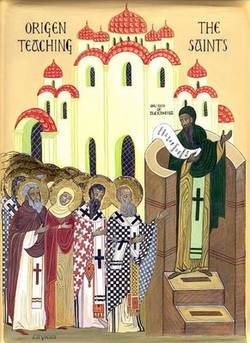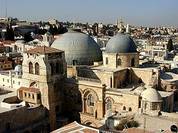
Church History: Apostolic Succession
In writing the first Church history to come down to us Bishop Eusebius of Caesarea (260-341) noted:
I confess that it is beyond my power to produce a perfect and complete history, and since I am the first to enter upon the subject, I am attempting to traverse as it were a lonely and untrodden path. I pray that I may have God as my guide and the power of the Lord as my aid, since I am unable to find even the bare footsteps of those who have traveled the way before me, except in brief fragments . . . (Church History, Book I)
Eusebius thus records a concern that modern historians would share, namely that history is an imperfect science. History is based upon a fragmented record of the past and cannot be recreated perfectly. His prayer, on the other hand, is reflective of his world view as a Christian. In fact, all Christian historians, hopefully, share a common world view grounded in faith.
Historians are well aware that it is not possible to eliminate all bias from one’s history since history is, in fact, an interpretation of the events and culture of a particular era seen through the lense of the historian. Though the historian seeks primary sources and strives for a level of impartiality, considering alternative theses and perspectives, he or she can never completely divorce themselves from their world view. Distinguished Church historian Warren H. Carroll, author of a five volume work, A History of Christendom, observes, “For the believing Christian, the dividing line between history and apologetics is always rather shadowy and artificial, since all truth is fundamentally one, and Christianity is pre‑eminently a historical religion" (Vol. I, 287).
So we should not be surprised to observe that Eusebius begins by establishing the divinity of Christ and the divine institution of his Church. Nor is it surprising to see him discuss the concept of apostolic succession as a primary focus, to demonstrate the historical basis of what some mistakenly consider only a theological concept. He sought to “preserve the memory of the successions of the apostles of our Saviour; if not indeed of all, yet of the most renowned of them in those churches which are the most noted, and which even to the present time are held in honor.” But first he testifies concerning St. Peter and St. Paul that:
both suffered martyrdom at the same time is stated by Dionysius, bishop of Corinth, in his epistle to the Romans, in the following words: ‘You have thus by such an admonition bound together the planting of Peter and of Paul at Rome and Corinth. For both of them planted and likewise taught us in our Corinth. And they taught together in like manner in Italy…’ (Book 2)
Eusebius goes on to mention both Linus and Clement as successors to the Chair of Peter and mentions the challenge facing him when he notes:
But the number and the names of those among them that became true and zealous followers of the apostles, and were judged worthy to tend the churches founded by them, it is not easy to tell, except those mentioned in the writings of Paul.
He notes that Paul’s disciples are mentioned both in his epistles and in the Acts of the Apostles, pointing out, “Timothy, so it is recorded, was the first to receive the episcopate of the parish in Ephesus, Titus of the churches in Crete.” Eusebius cites the writings of Tertullian and St. Irenaeus of Lyons, who argue that it is precisely apostolic succession which proves the Church Christ established against other heretical claimants. Thus, Bishop Irenaeus in an effort to oppose the Gnostic heretics wrote:
It is possible, then, for everyone in every church, who may wish to know the truth, to contemplate the tradition of the apostles which has been made known to us throughout the whole world. And we are in a position to enumerate those who were instituted bishops by the apostles and their successors down to our own times, men who neither knew nor taught anything like what these heretics rave about" (Against Heresies 3:3:1 [A.D. 189])
Evidence of apostolic succession then, can be found in Scripture and the writings of the Early Church Fathers such as Irenaeus. The Second Vatican Council states:
In order that the full and living Gospel might always be preserved in the Church, the apostles left bishops as their successors. They gave them 'their own position of teaching authority'. (Dei Verbum 7)
Indeed, "the apostolic preaching, which is expressed in the inspired books, was to be preserved in a continuous line of succession until the end of time." (Dei Verbum 8)
Thus, we observe in the earliest Church history of Eusebius and in the Early Church Fathers provide evidence of the concept of apostolic succession being used to distinguish the Church Christ established from others who would make similar claims. Apostolic succession is essential to the Church Christ established, which is truly catholic.
In writing the first Church history to come down to us Bishop Eusebius of Caesarea (260-341) noted:
I confess that it is beyond my power to produce a perfect and complete history, and since I am the first to enter upon the subject, I am attempting to traverse as it were a lonely and untrodden path. I pray that I may have God as my guide and the power of the Lord as my aid, since I am unable to find even the bare footsteps of those who have traveled the way before me, except in brief fragments . . . (Church History, Book I)
Eusebius thus records a concern that modern historians would share, namely that history is an imperfect science. History is based upon a fragmented record of the past and cannot be recreated perfectly. His prayer, on the other hand, is reflective of his world view as a Christian. In fact, all Christian historians, hopefully, share a common world view grounded in faith.
Historians are well aware that it is not possible to eliminate all bias from one’s history since history is, in fact, an interpretation of the events and culture of a particular era seen through the lense of the historian. Though the historian seeks primary sources and strives for a level of impartiality, considering alternative theses and perspectives, he or she can never completely divorce themselves from their world view. Distinguished Church historian Warren H. Carroll, author of a five volume work, A History of Christendom, observes, “For the believing Christian, the dividing line between history and apologetics is always rather shadowy and artificial, since all truth is fundamentally one, and Christianity is pre‑eminently a historical religion" (Vol. I, 287).
So we should not be surprised to observe that Eusebius begins by establishing the divinity of Christ and the divine institution of his Church. Nor is it surprising to see him discuss the concept of apostolic succession as a primary focus, to demonstrate the historical basis of what some mistakenly consider only a theological concept. He sought to “preserve the memory of the successions of the apostles of our Saviour; if not indeed of all, yet of the most renowned of them in those churches which are the most noted, and which even to the present time are held in honor.” But first he testifies concerning St. Peter and St. Paul that:
both suffered martyrdom at the same time is stated by Dionysius, bishop of Corinth, in his epistle to the Romans, in the following words: ‘You have thus by such an admonition bound together the planting of Peter and of Paul at Rome and Corinth. For both of them planted and likewise taught us in our Corinth. And they taught together in like manner in Italy…’ (Book 2)
Eusebius goes on to mention both Linus and Clement as successors to the Chair of Peter and mentions the challenge facing him when he notes:
But the number and the names of those among them that became true and zealous followers of the apostles, and were judged worthy to tend the churches founded by them, it is not easy to tell, except those mentioned in the writings of Paul.
He notes that Paul’s disciples are mentioned both in his epistles and in the Acts of the Apostles, pointing out, “Timothy, so it is recorded, was the first to receive the episcopate of the parish in Ephesus, Titus of the churches in Crete.” Eusebius cites the writings of Tertullian and St. Irenaeus of Lyons, who argue that it is precisely apostolic succession which proves the Church Christ established against other heretical claimants. Thus, Bishop Irenaeus in an effort to oppose the Gnostic heretics wrote:
It is possible, then, for everyone in every church, who may wish to know the truth, to contemplate the tradition of the apostles which has been made known to us throughout the whole world. And we are in a position to enumerate those who were instituted bishops by the apostles and their successors down to our own times, men who neither knew nor taught anything like what these heretics rave about" (Against Heresies 3:3:1 [A.D. 189])
Evidence of apostolic succession then, can be found in Scripture and the writings of the Early Church Fathers such as Irenaeus. The Second Vatican Council states:
In order that the full and living Gospel might always be preserved in the Church, the apostles left bishops as their successors. They gave them 'their own position of teaching authority'. (Dei Verbum 7)
Indeed, "the apostolic preaching, which is expressed in the inspired books, was to be preserved in a continuous line of succession until the end of time." (Dei Verbum 8)
Thus, we observe in the earliest Church history of Eusebius and in the Early Church Fathers provide evidence of the concept of apostolic succession being used to distinguish the Church Christ established from others who would make similar claims. Apostolic succession is essential to the Church Christ established, which is truly catholic.
 RSS Feed
RSS Feed

